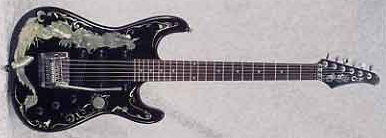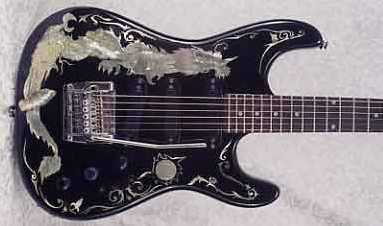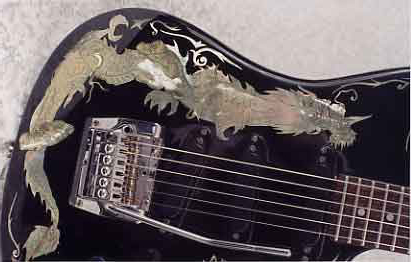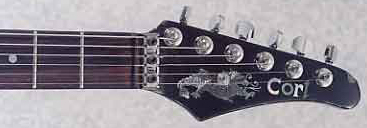The writhing, brightly colored paper dragons carried by a line of athletic young men to celebrate Chinese New Year is a sight most of us have seen. If you don’t live in a city with a Chinatown, you’ve at least seen them in a Stephen Segal movie. And if you’ve ever entered a Chinese gift shop, you’ve seen the gift boxes inlaid with colorful pearl and abalone dragons. The dragon is one of the most powerful images associated with East Asia. So, imagine my surprise when I first came upon a Cort Strat copy inlaid with a most spectacular mother-of-pearl and abalone dragon! What had I found?

1987 Cort Dragon Electric Guitar
Well, it’s always best to go to the source when you have a mystery (if you can), so I called Jack Westheimer to get the true story about my find. Jack’s name, unlike Leo or Orville, is probably not on most guitar fan’s lips, but he brought us Teisco (and other brand) guitars from Japan at a time when most folks in America didn’t think much about products from the Orient. There’s a whole lot more to this story that we don’t have time to get into here, but, long story short, Jack transferred from pioneering guitars in Japan to pioneering guitars in Korea. He took his Japanese Cortez guitars to the Peninsula in 1973, partnering with Yung H. Park, to create Cort guitars. Today they are one of the world’s top guitarmakers, and many Cort guitars are quite simply excellent instruments.
However, as you might expect, this quality achievement did not happen overnight. By Westheimer’s own assessment, it wasn’t until the mid-1980s that they felt quality was at a competitive level. But how to show it? He needed a guitar to make an impact on the U.S. market.

1987 Cort Dragon Electric Guitar
It was one day in around 1986 or ’87 while pondering this problem that Jack took a walk through an outdoor market that thrived outside the factory. There he encountered some of those gift boxes inlaid with fabulous pearl and abalone dragons. Maybe this was just the ticket. After a few inquiries he learned that the inlay work was done by craftsmen on a small island. He decided to take some Cort Strat and Explorer copies and have them inlaid with dragons.

1987 Cort Dragon Electric Guitar
What do they say about the litter on the road to success? Despite his best intentions, the project was doomed. The cost of the inlay was reasonable, but Cort had to finish the bodies, carefully pack them up, ship them to the village where the work was done, then have them shipped back, touch up any dings, then proceed to clear-coat and complete the guitar. By the time you added up all the extra handling, the guitars had to be sold for a pretty penny once they arrived Stateside. Dealers wouldn’t pay the freight for a Korean guitar, no matter how fancy.

1987 Cort Dragon Electric Guitar
Their loss was my gain. This is a swell little guitar with neck-through construction (my favorite) and even if it didn’t play well, which it does, it would be fun to stare at all day!
The Cort Dragons are pretty rare, uh, dragons. About 400 Explorers and 100 Strats (StoStats) were built in 1987. Most were Corts, but some came labeled Lotus. Of those, most were made with laminated bodies like this one; only 50 were made of solid timbers toward the end of the run.
In the long run, it only took time, consistency – and a mature global economy – to secure Cort’s reputation. They didn’t need the Dragons. But this one, at least, ended up in my treasure hoard, and every time I open the case it’s like Chinese New Year to me!

Just wondering if you know where i can get a solid body dragon mother of pearl inlay on a cort fender model. i think there were only 50 made. Any idea?
thank,
Greg Mckett
OMG! in ’87 I bought an Explorer Guitar EXACTLY THE SAME as this one that I paid $125 for NEW at a the Union Marketplace in Union NJ and the next day when I went back the Owner of the Guitar booth told me he sold me the Guitar for the wrong price and it should have been $425!
Needless to say Too Bad!
I have been more of a Collector than a Player and this Solid Body Lotus Explorer has sat in its case since ’87 bein played maybe 3 or 4 times and though the case has marks from storage I still have the wrench and Allen Wrench that came with it!
I Never Knew that only 50 were made and the reason I never could find another was because of the high cost to import them!
I’m open to Offers on this PRISTINE ’87 Dragon Inlay Lotus (Cort) Guitar Serial #854657 email: danielinnj@yahoo.com
Photo of My 1987 Lotus Explorer Solid body Dragon Inlaid Guitar:
http://tinyurl.com/1987-Lotus-Dragon-Explorer
Hey, Michael…
I don’t know if you check this blog entry or respond, but if you do can you tell me what the inlay is like over the forarm contour? Are the mother of pearl pieces simply bent and glued down? I’m actually considering inlaying a dragon on a strat somewhat like this, but I can’t find any information online about the angle being a problem with inlay work.
Hello there was just wondering if you have ever had any evaluation of these guitars? I have the same model as Daniel in NJ which he posted up for offers.
I just read a long article about the people who were responsible for Cortez {Cort} guitars coming to the U.S. They say that none were made in Korea they all were made in Japan!
I have the explorer model of this guitar as well. Nice to have a little more info on it. Thanks.
Looking to purchase a Cort Dragon Strat. Also open to the Explorer version, but mostly interested in the strat.
Contact me at scott@corpka.com.
Does anyone know what pickups are in the Explorer?
I just got a red strat dragon in today. I will have it up on Reverb in a couple of days
Contact me at Monster Music in Levittown, NY
Anyone looking for a Cort Dragon? I’ve got this listed on Reverb now: https://reverb.com/item/13179200-cort-dragon-ex-style
Thanks